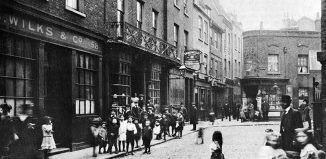The Goldsmiths’ Company: Exclusive behind the scenes access
Kate Youde goes behind the scenes of the Goldsmiths’ Company and meets some of the people upholding the traditions of the 700-year-old institution – one of the oldest consumer watchdogs in the world
Not many people get to lift a Grand National trophy, but handling famous sporting silverware is a very normal part of the job for Candice Devine.
Working for the Goldsmiths’ Company Assay Office in London, Candice hallmarks objects made from precious metals to prove their authenticity. “It’s great to handle the item which I then see presented on the TV,” she says. With her precise work, hand striking metal, she is preserving a craft that has existed for more than 700 years. The Goldsmiths’ Company has been responsible for testing (assaying) gold and silver since 1300, when King Edward I passed a statute requiring items made from those precious metals to be ‘marked with the leopard’s head’ to prevent fraud by goldsmiths.
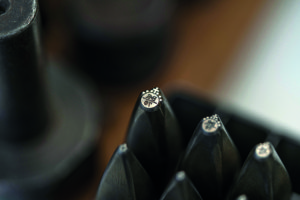
The City of London livery company received its first royal charter in 1327 and established the country’s first assay office in 1478. At that time, makers would take their wares to Goldsmiths’ Hall, the company’s now Grade I-listed headquarters, to be tested and marked – hence the term ‘hallmark’.
Today, the Goldsmiths’ Company Assay Office is spread across four sites in the capital, including the original branch at Goldsmiths’ Hall. It is one of four assay offices in the UK; the others are in Birmingham, Sheffield, and Edinburgh. Last year, they hallmarked a combined total of more than 8.5 million articles made from gold, silver, platinum or palladium, but the offices are run separately. “A colleague of mine has a good analogy,” says Will Evans, general manager of the Goldsmiths’ Company Assay Office. “It’s like garages doing MOTs, so it’s a standard service, but all done differently.”
This standard service is testing items made from precious metals to ensure they are the metal and purity the person submitting them for testing says they are, and then marking the items to show they passed the tests. By law, anything sold in the UK as gold, silver, platinum, or palladium must be hallmarked, even if it is made elsewhere. Will’s office handles everything, from simple picture frames to expensive jewellery.
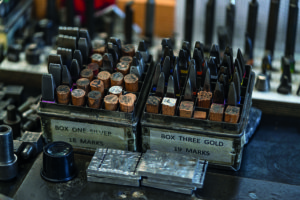
When Will first started out as a laboratory assistant 22 years ago, a gold ring would be tested by cutting away 200mg of metal and sending the sample to a laboratory, where technicians would refine the pure metal out of that sample in a process called cupellation. If it passed the test, the ring would then be hallmarked and returned to the jeweller’s workshop to be finished, ready for sale.
Now, thanks to advances in technology, there is a non-destructive testing method. “We fire X-rays at the piece and then they’re returned to the detector in the instrument at different wavelengths depending on the material that they’ve come from,” says Will. “The machine then measures the intensity of those different wavelengths and converts that into a fineness figure.” Less than 1 per cent of the items tested by Will’s team are rejected; when items do fail, it is more because of “error than nefarious intent” he says.
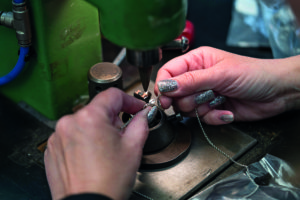
Once a piece has passed, it is hallmarked by laser, press, or hand, depending on the wishes of the customer. Most of Candice’s time is spent hand stamping items, for which she uses specially made steel punches that have the characters of a hallmark lasered onto the tip. There are straight and swan neck punches, with the latter used to stamp the inside of rings.
To make a mark, Candice puts the punch on the metal being stamped and hits it with a hammer. It is intricate work: each mark is between 0.3mm and 6mm high. “If it’s a really big mark like a 6mm mark, we have to hit it harder,” says Candice, who in 2016 became the first woman to complete the organisation’s four-year apprenticeship and is now an assay assistant and head of training. “If it’s a small mark you would need just a little tap,” she adds.
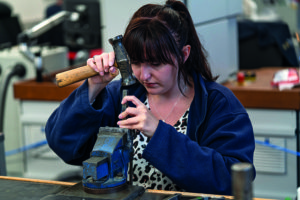
A typical hallmark Candice applies is made up of five marks in a discrete line that indicates who sent the item for testing, the metal, and its fineness, and where and when it was hallmarked [see panel on previous page]. However, the more complicated bespoke marks can be arranged in various patterns, for example dotted around the outside of a ring. “You’ve got a different challenge every day,” she says. People sending items for hallmarking can also request additional optional marks such as a commemorative mark that signifies a special event. This year, precious metals can be stamped with a mark celebrating the Queen’s Platinum Jubilee. Designed by Thomas Fattorini, a 195-year-old, family-run business that specialises in crafting emblematic jewellery and insignia, the mark depicts an orb with the Queen’s cypher and the number 70 at its centre.

It has proved popular, creating extra work for Candice and her colleagues, who hallmark about one million items at the Goldsmiths’ Hall each year.
Yet, while the volume of work might have increased since 1478, the Goldsmiths’ Company Assay Office still serves the same purpose. “Hallmarking is one of the oldest forms of consumer protection,” says Will. “What we’re doing is guaranteeing that the consumer, when they purchase that item in the shop, is getting what they pay for and what that item is described as.”

Though the Assay Office is not open to the public, The Goldsmiths’ Hall opens once a year during the Goldsmiths’ Fair from late September to early October. Find out more at goldsmithsfair.co.uk
This is an extract, read the full feature in the October/November 2022 issue of Discover Britain, out on 9 September.
Read more:





